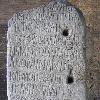

Inscription for 5th century Roman Consul Decius Marius Venantius Basilius in the Colosseum in Rome. Tags: Latin View |
Tags: Latin View |
Latin (lingua lat?na, IPA-lala?ti?naIPA) is an Italic language originally spoken in Latium and Ancient Rome. Although often considered a dead language (Language death), in view of the fact that it has no native, fluent speakers, Latin continues to be taught in schools and has been, and currently is, used in the process of new word production in modern languages from many different families, including English (English language). Latin and its daughter Romance languages are the only surviving branch of the Italic language family. Other branches, known as Italic languages (Old Italic), are attested in documents surviving from early Italy, but were assimilated during the Roman Republic. The one possible exception is Venetic, the language of the people who founded Venice, who in Roman times spoke their language in parallel with Latin and later were assimilated to Italian. In another theory, however, Venetic was not an Italic language, but was an independent branch.
The extensive use of elements from vernacular speech by the earliest authors and inscriptions of the Roman Republic make it clear that the original, unwritten language of the Roman Monarchy was a colloquial (Colloquialism) form only partly reconstructable called Vulgar Latin. By the late Roman Republic literate persons mainly at Rome had created a standard form from the spoken language of the educated and empowered now called Classical Latin, then called simply Latin or Latinity. The term Vulgar Latin came to mean the various dialects of the citizenry. With the Roman conquest (Military history of the Roman Empire), Latin spread to countries around the Mediterranean, and the vernacular dialects spoken in these areas developed into the Romance languages, including Aragonese, Catalan (Catalan language), Corsican, French (French language), Italian (Italian language), Portuguese (Portuguese language), Romanian (Romanian language), Sardinian, and Spanish (Spanish language). Classical Latin, however, continued to develop after the fall of the Roman Empire and through the Middle Ages, and was used as the language of international communication, scholarship and science until the 17th century, when it was supplanted by vernacular languages.
Latin is a highly inflected language (fusional language), with three distinct genders, six noun cases, four verb conjugations, six tenses, six persons, three moods, two voices, two aspects and a distinction between singular and plural. A dual is rare and archaic. One of the six cases is the locative case, generally only used with place nouns. Adjectives and adverbs are compared, and adjectives are inflected for case, gender, and number. Although Latin has demonstrative pronouns indicating varying degree of closeness, it lacks articles. Later Romance language articles developed from the demonstative pronouns; e.g., le and la from ille and illa. Romance languages were created by simplification of this inflectional complexity in various ways; e.g., uninflected Italian oggi ("today") from the Latin ablative case, hoc die.
Nativename: lang-laLingua latina
Pronunciation: IPA-lala?ti?na
States: Roman Republic, Roman Empire, Medieval Europe, Armenian Kingdom of Cilicia (as lingua franca), flagiconVAT Vatican City
Familycolor: Indo-European
Fam2: Italic (Italic languages)
Fam3: Latino-Faliscan (Latino-Faliscan languages)
Map: Greatest extent of the Roman Empire, the maximum range over which Latin was spoken. (File:Roman Empire map.svgcenterthumb)
Nation: Holy See
Agency: Anciently, Roman schools of grammar and rhetoric. In contemporary time, Opus Fundatum Latinitas.
Iso1: laiso2=latiso3=lat


